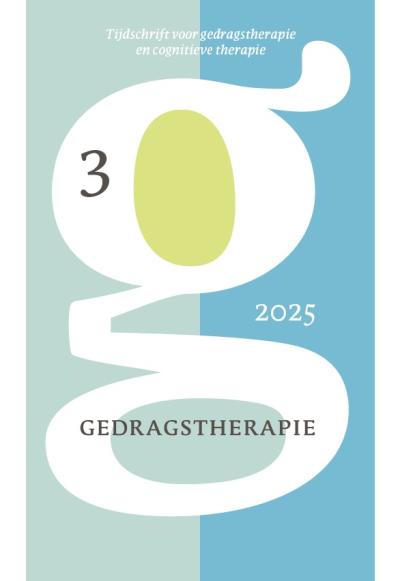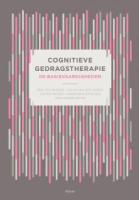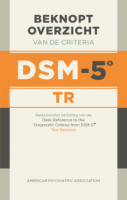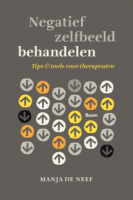Inhoud
Een logboek van positieve ervaringen draagt bij tot angstreductie in exposure therapie: een studie bij tandartsfobie
Samenvatting
De eerste keus behandeling van specifieke fobieën is exposure in vivo. Mensen die lijden aan een fobie denken herhaaldelijk negatief over angstwekkende stimuli en richten hier selectief hun aandacht op. Dit kan de positieve ervaringen opgedaan tijdens de exposuresessies verminderen, waardoor extinctie minder effectief verloopt. In deze vergelijkende studie is onderzocht of het richten van de aandacht op positieve leerervaringen, middels het gebruik van een ‘logboek van positieve ervaringen' (LPE), in een sterkere angstreductie resulteert bij behandelingen van tandartsfobie - een van de meest voorkomende fobieën in Nederland.
Volwassen patiënten met een tandartsfobie werden op basis van loting toegewezen aan een controlegroep (n = 26, gebruikelijke behandeling) of een experimentele groep (n = 22, additionele toepassing LPE). Tandartsangst werd voorafgaand aan sessies 1, 3 en 5 gemeten met de Dental Anxiety Scale, Korte vragenlijst Angst Tandheelkundige Behandeling en de Anxiety Score. Deze lijsten meten de dispositieangst en het algemene angstniveau voor de tandheelkundige behandeling.
Alle angstscores daalden sterker in de experimentele groep dan in de controlegroep. Opmerkelijk was dat dit effect vroeg optrad: al voor de derde sessie. Het LPE blijkt meerwaarde te hebben voor de effectiviteit en efficiëntie van exposurebehandelingen van tandartsfobie. Toekomstig onderzoek moet uitwijzen of het LPE ook bij andere angststoornissen van toegevoegde waarde kan zijn.
Literatuur
- Aartman, I.H A. (1998) Reliability and validity of the short version of the Dental Anxiety Inventory. Community of Dental and Oral Epidemiology, 26, 350-354.
- Aartman, I.H., Jongh, A. de, Makkes, P.C., & Hoogstraten J. (2000). Dental anxiety reduction and dental attendance after treatment in a dental fear clinic: a follow-up study. Community Dentistry and Oral Epidemiology, 28, 435-442.
- Abbott, M.J., & Rapee, R.M. (2004). Post-event rumination and negative self-appraisal in social phobia before and after treatment. Journal of Abnormal Psychology, 113, 136-144.
- American Psychiatric Association. (2000). Diagnostic and statistical manual of mental disorders, (4th ed., text revision). Washington, DC, US: American Psychiatric A ssociation.
- Bar-Haim, Y., Lamy, D., Pergamin, L., Bakermans-Kranenburg, M.J., & IJzendoorn, M. H. van. (2007). Threat-related attentional bias in anxious and nonanxious individuals: a meta-analytical study. Psychological Bulletin, 133, 1-24.
- Bar-Haim, Y. (2010). Research review: attention bias modification (ABM): a novel treatment for anxiety disorders. Journal of Child Psychology and Psychiatry, 51, 859-870.
- Chellappah, N., Vignehsa, H., Milgrom, P., & Lam, L. (1990). Prevalence of dental anxiety and fear in children in Singapore. Community Dentistry and Oral Epidemiology, 18, 269-271.
- Cohen, S., Fiske, J., & Newton, J. (2000). The impact of dental anxiety on daily living. Behavioural Dentistry, 7, 385-390.
- Corah, N. (1969). Development of a dental anxiety scale. Journal of Dental Research, 48, 596.
- Fava, G.A., & Ruini, C. (2003). Development and characteristics of a well-being enhancing psychotherapeutic strategy: well-being therapy. Journal of Behavior Therapy and Experimental Psychiatry, 34, 45-63.
- Fennell, M.J.V., & Teasdale, J.D. (1987). Cognitive therapy for depression: Individual differences and the process of change. Cognitive Therapy and Research, 11, 253-271.
- Ilardi, S.S. & Craighead, W.E. (1994). The role of nonspecific factors in cognitive-behavior therapy for depression. Clinical Psychology: Science and Practice, 1, 138–156.
- Jacobson N.S., & Truax, P. (1991). Clinical significance: A statistical approach to defining meaningful change in psychotherapy research. Journal of Consulting and Clinical Psychotherapy, 59, 12-19.
- Jongh, A. de, Muris, P., Horst, G. ter, & Duyx, M.P. (1995). Acquisition and maintenance of dental anxiety: the role of conditioning experiences and cognitive factors. Behaviour Research and Therapy, 33, 205-210.
- Jongh, A. de (2006). Angst voor de tandarts. Assen: Koninklijke Van Gorcum BV.
- Korrelboom, K., & Broeke, E. ten (2009). Geïntegreerde cognitieve gedragstherapie. Handboek voor theorie en praktijk. Bussum: Uitgeverij Coutinho.
- Kraaij, V., Garnefski, N., & Van Gerwen, L. Cognitive coping and anxiety symptoms among people who seek help for fear of flying. Aviation, Space, and Environmental Medicine, 74, 273-277.
- Landelijke Stuurgroep Multidisciplinaire Richtlijnontwikkeling in de GGZ. (2003). Multidisciplinaire richtlijn Angststoornissen. Richtlijn voor de diagnostiek, behandeling en begeleiding van volwassen cliënten met een angststoornis. Utrecht: Trimbosinstituut.
- Landelijke Stuurgroep Multidisciplinaire Richtlijnontwikkeling in de GGZ. (2010). Richtlijnherziening van de Multidisciplinaire richtlijn Angststoornissen (eerste revisie). Richtlijn voor de diagnostiek, behandeling en begeleiding van volwassen patiënten met een angststoornis. Utrecht: Trimbos-instituut.
- Lissek, S., Biggs, A.L., Rabin, S.J., Cornwell, B.R., Alvarez, R.P., Pine, D.S., & Grillon, C. (2008). Generalization of conditioned fear-potentiated startle in humans: experimental validation and clinical relevance. Behaviour Research and Therapy, 46, 678687.
- Locker, D. (2003). Psychosocial consequences of dental fear and anxiety. Community Dentistry and Oral Epidemiology, 31, 144-151.
- Locker, D., Poulton, R.,& Thomson, W.M. (2001). Psychological disorders and dental a nxiety in a young adult population. Community Dentistry and Oral Epidemiology, 29, 456-463.
- Lopez, S.J., Magyar-Moe, J.L, Petersen, S.E., Ryder, J.A., Krieshok, T.S., O'Byrne, K.K., Lichtenberg, J.W., & Fry, N.A. (2006). Counseling psychology's focus on positive aspects of human functioning. The Counseling Psychologist, 34, 205-207.
- Mathews, A., & Mackintosh, B. (2000). Induced emotional interpretation bias and anxiety. Journal of Abnormal Psychology, 109, 602-615.
- Newton, J., & Buck, D. (2000). Anxiety and pain measures in dentistry: a guide to their quality and application. Journal of the American Dental Association, 131, 1449-1457.
- Oosterink, F.M., Jongh, A. de, & Hoogstraten, J. (2009). Prevalence of dental fear and phobia relative to other fear and phobia subtypes. European Journal of Oral Sciences, 117, 135-143.
- Oosterink F.M., Jongh, A. de & Aartman I.H. (2008). What are people afraid of during dental treatment? Anxiety-provoking capacity of 67 stimuli characteristics of dental setting. European Journal of Oral Sciences, 116, 44-51.
- Salemink, E., Hout, M. van den, & Kindt, M. (2009). Effects of positive interpretive bias modification in highly anxious individuals. Journal of Anxiety Disorders, 23, 676-683.
- Smedt, C. de, & Pieters, G. (1999). Cognitief-gedragstherapeutische benadering van sociale fobie. Tijdschrift voor Psychiatrie, 41, 641-650.
- Stouthard, M. E. (1989). Fear of dental treatment (Proefschrift). Amsterdam: Universiteit van Amsterdam, Nederland, Academisch Centrum Tandheelkunde Amsterdam.
- Stouthard, M.E., & Hoogstraten, J. (1990). Prevalence of dental anxiety in the Netherlands. Community Dentistry and Oral Epidemiology, 18, 139-142.
- Tang, T.Z., & DeRubeis, R.J. (1999). Reconsidering rapid early response in cognitive behavioral therapy for depression. Clinical Psychology: Science and Practice, 6, 283-288.
- Vermaire, J.H., Jongh, A. de, & Aartman, I.H. (2008). Dental anxiety and Quality of Life: the effect of dental treatment. Community Dentistry and Oral Epidemiology, 36, 409-416.
- Wilson, G.T. (1999). Rapid response to cognitive behavior therapy. Clinical Psychology: Science and Practice, 6, 289-292.
 © 2009-2025 Uitgeverij Boom Amsterdam
© 2009-2025 Uitgeverij Boom Amsterdam
De artikelen uit de (online)tijdschriften van Uitgeverij Boom zijn auteursrechtelijk beschermd. U kunt er natuurlijk uit citeren (voorzien van een bronvermelding) maar voor reproductie in welke vorm dan ook moet toestemming aan de uitgever worden gevraagd:
Behoudens de in of krachtens de Auteurswet van 1912 gestelde uitzonderingen mag niets uit deze uitgave worden verveelvoudigd, opgeslagen in een geautomatiseerd gegevensbestand, of openbaar gemaakt, in enige vorm of op enige wijze, hetzij elektronisch, mechanisch door fotokopieën, opnamen of enig andere manier, zonder voorafgaande schriftelijke toestemming van de uitgever.
Voor zover het maken van kopieën uit deze uitgave is toegestaan op grond van artikelen 16h t/m 16m Auteurswet 1912 jo. Besluit van 27 november 2002, Stb 575, dient men de daarvoor wettelijk verschuldigde vergoeding te voldoen aan de Stichting Reprorecht te Hoofddorp (postbus 3060, 2130 KB, www.reprorecht.nl) of contact op te nemen met de uitgever voor het treffen van een rechtstreekse regeling in de zin van art. 16l, vijfde lid, Auteurswet 1912.
Voor het overnemen van gedeelte(n) uit deze uitgave in bloemlezingen, readers en andere compilatiewerken (artikel 16, Auteurswet 1912) kan men zich wenden tot de Stichting PRO (Stichting Publicatie- en Reproductierechten, postbus 3060, 2130 KB Hoofddorp, www.cedar.nl/pro).
No part of this book may be reproduced in any way whatsoever without the written permission of the publisher.
Inloggen VGCt en VVGT
Leden van de VGCt en de VVGT loggen in via de site van hun vereniging. Als u op die site bent ingelogd als lid, vindt u daar een button naar het Tijdschrift voor Gedragstherapie.
English
Behavioral Therapy: Journal for Behavioral Therapy and Cognitive Therapy ISSN 0167-7454
Information in English can be found here.







